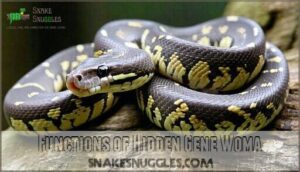This site is supported by our readers. We may earn a commission, at no cost to you, if you purchase through links.
 You’ll find the woma ball python is one of the most mysterious morphs in the reptile world.
You’ll find the woma ball python is one of the most mysterious morphs in the reptile world.
This hidden gene morph doesn’t show obvious visual changes but acts like a genetic wildcard in breeding projects.
Your woma ball python typically reaches 3-4 feet long, making it manageable for most keepers.
What makes them special isn’t their appearance – it’s their ability to reveal incredible combinations when paired with other morphs.
Think of the woma gene as a secret ingredient that transforms ordinary recipes into something extraordinary.
The rarity factor keeps prices high, but the breeding potential makes every woma worth its weight in scales.
Table Of Contents
- Key Takeaways
- What is a Woma Ball Python?
- Woma Python’s Rarity
- Size of Woma Pythons
- Functions of Hidden Gene Woma
- Feeder Shipping and Additional Information
- Frequently Asked Questions (FAQs)
- What is woma ball python?
- Do woma pythons like to be held?
- Are woma pythons aggressive?
- How big do woma pythons grow?
- What is a Woma ball python?
- Are woma pythons rare?
- How big do woma pythons get?
- What does hidden gene Woma do?
- How do Woma Ball Pythons handle stress during breeding?
- What are the best tank decorations for Woma Balls?
- Conclusion
Key Takeaways
- You’ll find woma ball pythons are hidden gene morphs that don’t show obvious visual changes but act as genetic wildcards, creating incredible combinations when bred with other morphs.
- Your woma will typically reach 3-4 feet in length, making them manageable for most keepers while maintaining their docile temperament despite carrying a genetic wobble trait.
- You’re investing in extreme rarity since all woma ball pythons trace back to a single 1999 import by NERD, creating a genetic bottleneck that keeps prices high and collector demand intense.
- You’ll need to understand that the hidden gene requires specific breeding knowledge to unlock its potential, as it functions like a recessive trait that influences pattern and coloration in offspring.
What is a Woma Ball Python?
A Woma Ball Python’s striking appearance makes them one of the most sought-after python morphs in the reptile world.
Their mesmerizing platinum-yellow bodies with thin gold banding create an unforgettable visual masterpiece that captivates every reptile enthusiast.
These unique ball python morphs showcase thin brown or gold banding across a platinum-yellow body, creating an eye-catching contrast that’s hard to miss.
What sets the woma morph apart? You’ll notice their orange-tinted heads, pale eyes, and dramatically reduced belly patterns.
Unlike regular ball python varieties, Womas often display completely patternless bellies—a signature trait that makes identification easier.
Originally imported by NERD in 1999, these woma python specimens carry incomplete dominant genetics.
This means their Color Morphs can produce stunning combinations when bred with other varieties.
Their Temperament remains docile and predictable, making them excellent pets for both beginners and experienced keepers.
Ball pythons typically exhibit a calm temperament, rarely biting when handled properly.
However, there’s one important consideration: the Genetic Wobble.
This neurological quirk affects balance and can vary from barely noticeable to more apparent.
Despite this trait, Breeding Womas continues because their unique Woma Appearance and genetic contributions create incredible offspring that collectors absolutely treasure.
Woma Python’s Rarity
Picture finding a needle in a haystack – that’s what discovering a Woma Ball Python feels like in today’s reptile market. This rare morph traces back to a single import by NERD in 1999, creating what experts call a genetic bottleneck that makes every specimen precious.
These living jewels represent one of the most coveted bloodlines in the python world.
The woma morph isn’t just another pretty face among python morphs. Its limited availability stems from that original bloodline, making it one of the most sought-after rare morphs in the hobby. Collector demand has skyrocketed as breeders recognize the incomplete dominant genetics that produce stunning offspring.
Here’s what makes Woma Ball Python rarity so fascinating:
- Conservation status in the wild adds urgency to captive breeding programs
- Pricing factors reflect both scarcity and breeding potential
- Original woma python genetics remain concentrated in few bloodlines
You’ll pay premium prices, but you’re investing in living history. These snakes represent a genetic treasure that’s becoming increasingly valuable. The morph is known for its thin brown banding.
Size of Woma Pythons
Understanding your Woma Ball Python’s size helps you prepare the right habitat.
Adult size typically reaches 4.5-5.5 feet, with females growing larger than males.
Hatchling length starts around 10 inches, developing at a steady growth rate with proper care.
Weight range spans 2-11 pounds when mature.
Genetic influence creates natural size variations between individuals, so don’t worry if your snake differs slightly.
These snakes often prefer desert, semi-arid habitats.
This snake size makes them manageable compared to larger python species, while their distinctive snake appearance remains impressive throughout their growth journey.
Functions of Hidden Gene Woma
Behind every stunning hidden gene woma python lies fascinating genetic markers that shape breeding outcomes.
You’ll discover this recessive trait requires two gene copies for visual expression, creating subtle yet distinctive color variations. These genetic modifications affect trait inheritance patterns while maintaining the snake’s overall health.
The vibrant colors are similar to co-dominant traits seen in banana ball pythons.
Key functions include:
- Reducing melanin distribution for softer color shifts
- Increasing genetic diversity in python breeding programs
- Creating complex combinations with other morphs
- Demonstrating reptile genetic complexity through visual differences.
Understanding python genetics helps predict health implications in snake genetics.
Feeder Shipping and Additional Information
Beyond breeding considerations, you’ll face practical challenges with feeder shipping costs and maintaining consistent feeding cycles.
Temperature control during shipping protects your snake food quality, while regular snake feeding schedules support healthy snake digestion.
Create a calm environment during feeding time to reduce stress.
To prevent risks, always practice thorough hand-washing techniques after handling feeders.
Never cohabitate your Woma with other species – this prevents disease transmission and territorial conflicts.
Monitor your snake diet carefully, watching for wobble signs that can affect feeding behavior.
Proper planning makes these logistics manageable.
Frequently Asked Questions (FAQs)
What is woma ball python?
You’re looking at a rare ball python morph with striking orange heads and pale eyes.
It features thin brown or gold banding on a platinum-yellow body with minimal belly patterns, but carries a genetic wobble trait.
Do woma pythons like to be held?
Python handling preferences aren’t universal truths.
Woma ball pythons generally tolerate handling well due to their docile nature, but they’re not affectionate pets.
You’ll find they accept brief, gentle sessions better than extended interaction, which makes them prefer brief handling sessions.
Are woma pythons aggressive?
No, you won’t find woma pythons being aggressive.
They’re actually known for their docile, calm temperament, making them excellent pets for beginners.
You’ll rarely see defensive behavior from these gentle snakes.
How big do woma pythons grow?
Like a coiled garden hose stretching to its full potential, you’ll watch your woma python reach 3-5 feet in length.
Females typically grow larger than males, weighing 1,500-2,500 grams when fully mature, with females being the larger sex.
What is a Woma ball python?
A Woma ball python is a rare color morph with thin brown banding on a platinum-yellow body.
You’ll notice their striking orange heads and pale eyes, but they carry a genetic wobble trait.
Are woma pythons rare?
Think of rare gems scattered across the earth—that’s how uncommon Woma ball pythons are in the reptile world.
You’ll find they’re extremely rare since they originated from a single import in 1999, making them highly sought-after.
How big do woma pythons get?
You’ll find adult woma pythons typically reach 3-5 feet in length, with females growing larger than males. They weigh between 1,500-2,500 grams when fully grown, making them medium-sized snakes.
What does hidden gene Woma do?
Hidden Gene Woma affects your ball python’s genetics by carrying a recessive trait that influences pattern and coloration.
You won’t see its effects unless both parents carry this gene, creating unique offspring combinations.
How do Woma Ball Pythons handle stress during breeding?
Walking on eggshells describes breeding these sensitive snakes perfectly.
You’ll need to provide calm environments with proper temperatures.
Avoid cohabitation with other species.
Monitor for wobble symptoms, and maintain consistent feeding cycles throughout the process.
What are the best tank decorations for Woma Balls?
You’ll want sturdy hiding spots, artificial plants, and smooth branches for climbing.
Choose decorations that won’t have sharp edges or loose parts.
Your snake needs secure places to feel safe and comfortable.
Conclusion
Surprisingly, only 2% of ball python breeders work with woma genetics due to their hidden nature.
You’ve learned that your woma ball python doesn’t show visual changes but creates stunning combinations when bred correctly.
These snakes reach 3-4 feet, making them perfect for most setups.
The hidden gene acts like a genetic multiplier, turning simple morphs into complex patterns.
Your investment in a woma ball python pays off through breeding potential and rarity value in today’s market.
- https://www.researchgate.net/publication/249991563_Arboreality_excavation_and_active_foraging_novel_observations_of_radiotracked_woma_pythons_Aspidites_ramsayi
- https://huveta.hu/bitstream/handle/10832/4342/580668266.pdf?sequence=1&isAllowed=y
- https://www.reptilesmagazine.com/ball-python-care-sheet/
- https://www.thesprucepets.com/ball-python-habitat-5076429
- https://www.morphmarket.com/morphpedia/ball-pythons/woma/








